ॐ श्री गणाधिपतये नमः
Source of all Images in this Blog-post : Google Images : ‘Google Image Search’ will reveal the multiple sources of every single image shared in this Blog. For more details, kindly see ‘Disclaimer‘
Buy Kerala’s Mural Paintings Online on Amazon India
Introduction
Imagine standing before a sprawling wall, where a cascade of colors unfolds a story from an ancient world. This is the opening scene of a Kerala mural, a symphony in hues of saffron, green, and ochre, masterfully applied to narrate tales steeped in mythology and tradition. These murals, more than just art, are the soulful expressions of a rich cultural heritage, embedded in the very walls of Kerala’s revered temples and palaces.
Kerala murals represent a unique fusion of art and spirituality, depicting scenes from Hindu epics and Puranas. Originating between the 9th and 12th centuries, these paintings have survived centuries, encapsulating the essence of an era when art was not just seen but felt deeply. Each stroke, each color choice in these murals, tells a story of devotion, artistry, and the enduring spirit of Kerala’s rich traditions. This is more than art; it’s a vivid journey through time, narrating stories that have shaped the cultural landscape of this region.
Buy Kerala’s Mural Paintings Online on Amazon India
Buy Kerala’s Mural Paintings Online on Amazon India
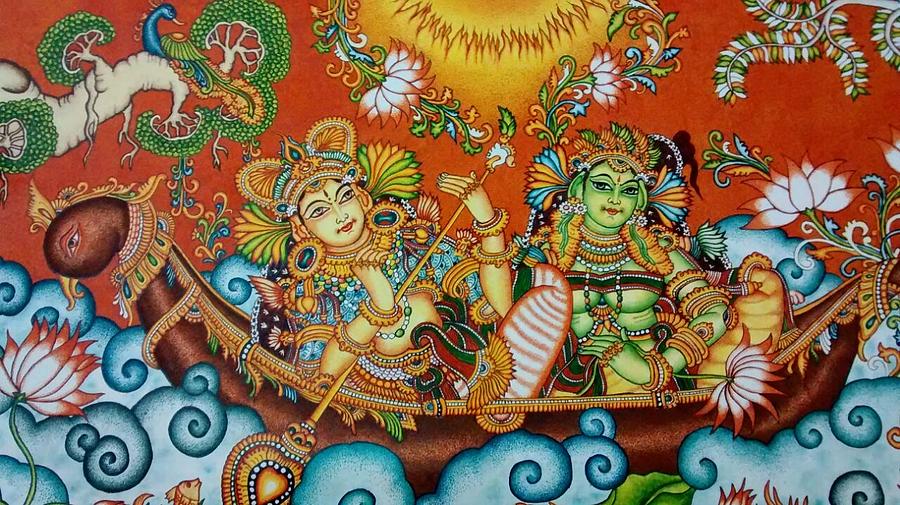
Watch a Series of Videos on Kerala’s Mural Paintings Including Tutorials on Google Videos
The Historical Saga of Kerala Murals
The story of Kerala mural paintings is an enchanting journey through centuries, beginning in the 9th century. It was an era of artistic enlightenment when the walls of temples and palaces started speaking the language of colors and legends.
During the early phase, between the 9th and 11th centuries, mural art flourished under royal patronage. The Thirunandikkara Cave Temple, now a part of Tamil Nadu, stands testament to this period, showcasing some of the earliest examples of Kerala’s distinct style. These initial murals were characterized by simplicity and elegance in their line drawings.
As we move into the 12th century, Kerala murals began to adopt more intricate designs, reflecting a maturing art form. The Mattancherry Palace, a significant landmark from this period, is adorned with vibrant murals depicting the Ramayana. These paintings are not just art; they are a frozen echo of the bygone era, narrating stories that form the bedrock of Kerala’s cultural ethos.
The zenith of Kerala mural art was witnessed between the 16th and 19th centuries, coinciding with the Bhakti Movement’s influence. This period saw a fusion of religious devotion and artistic expression, creating a legacy of murals that continue to awe viewers with their beauty and intricacy.
Each era brought its own flavor to the mural art of Kerala, turning walls into canvases of historical storytelling, where mythologies came alive in a spectrum of colors. These murals are more than art; they are a living history of Kerala’s rich past and enduring traditions.
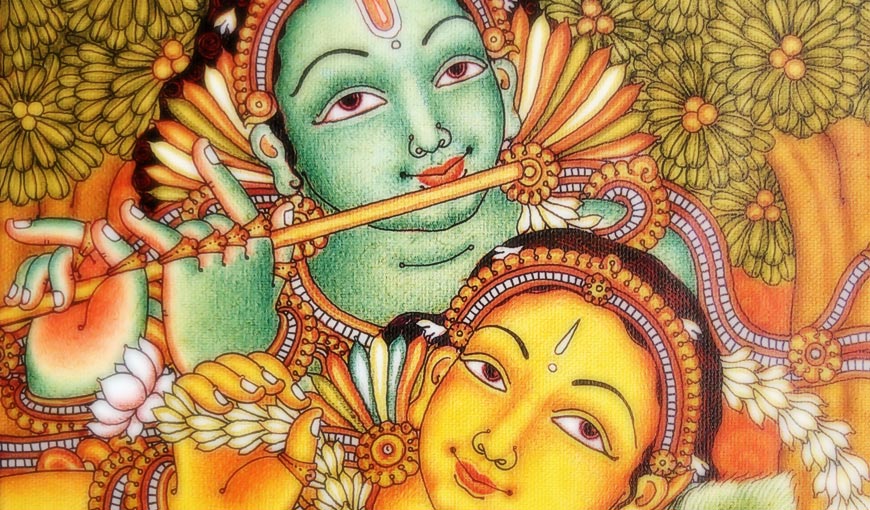
Watch a Series of Videos on Kerala’s Mural Paintings Including Tutorials on Google Videos
Artistic Techniques and Styles of Kerala Murals
Kerala mural paintings stand out for their unique artistic techniques and styles, deeply rooted in tradition and symbolism. These murals are characterized by their use of natural pigments, derived from plants and minerals, creating a palette rich in earthy tones. Colors like saffron-red, green, and indigo are commonly used, each carrying its own symbolic weight.
The style of depiction in Kerala murals is marked by their strict adherence to iconography as prescribed in ancient texts. The figures are stylized with exaggerated eyes and elongated limbs, evoking a sense of divine presence. The themes commonly revolve around Hindu mythology, primarily depicting gods and goddesses, and scenes from epics like the Ramayana and Mahabharata. These murals are not just visual narratives; they are spiritual gateways, inviting viewers to delve into the profound depths of Indian mythology and philosophy.
The cultural significance of these themes lies in their ability to connect the past with the present, offering a glimpse into the spiritual and artistic consciousness of ancient India. Every mural tells a story, a piece of folklore, or a mythological tale, thereby preserving and perpetuating the cultural and religious heritage of Kerala.
Kerala’s Diverse Mural Landscapes: From Temples to Churches and Palaces
Kerala’s rich tapestry of mural art extends beyond its famed temples to churches and palaces, each offering a unique glimpse into this vibrant art form. Temples like Trikodithanam, Vaikom, Pundarikapuram, Udayanapuram, Triprangode, Guruvayoor, Kumaranalloor, Aymanam, Vadakkunathan in Thrissur, Thodeekkalam in Kannur, and Sri Padmanabhaswamy in Thiruvananthapuram are adorned with exquisite murals. Similarly, churches in Ollur, Chalakkudy, Kanjoor, Edappally, Vechur, and Mulanthuruthy, and palaces like Krishnapuram near Kayamkulam and Padmanabhapuram, also house remarkable mural paintings, each narrating stories and traditions through their distinctive artistry.
Buy Kerala’s Mural Paintings Online on Amazon India

Watch a Series of Videos on Kerala’s Mural Paintings Including Tutorials on Google Videos
The Kerala Mural Artists’ Narrative
In the heart of Kerala, where the tradition of mural painting breathes life into walls, the artists behind these masterpieces weave their own unique stories. Meet Suresh, a third-generation mural artist from Thrissur, who speaks passionately about inheriting this art form from his forefathers. “Each mural I paint is a conversation with my ancestors,” he says, his hands skillfully tracing the divine contours of a goddess.
Then there’s Anjali, a young artist from Kochi, who has taken up the brush to keep this ancient art alive in modern times. She finds inspiration in the lush landscapes of Kerala, “The colors of our murals are a reflection of the vibrant nature that surrounds us,” she explains.
These artists face their share of challenges, from the painstaking process of preparing natural pigments to preserving the authenticity of the art in a rapidly changing world. Yet, their dedication is unwavering. As Suresh puts it, “Each line we draw, each color we mix, is a tribute to our rich heritage.”
Capturing these artists at work, photographs reveal their focused expressions and skilled hands, a testament to the enduring legacy of Kerala’s mural tradition. These images are not just snapshots of their work but a window into a world where art and devotion merge seamlessly.
Revival of Kerala Mural Art
The revival of Kerala mural art represents a remarkable turnaround from its near extinction during British rule, when traditional artisans lost patronage. Post-India’s independence in 1947, a significant resurgence occurred, breathing new life into this ancient tradition. Key to this revival was the establishment of institutions like the Centre for Study of Mural Paintings by the Guruvayur Devaswom Board in Thrissur, under the guidance of Mammiyoor Krishnan Kutty Nair, and the Sree Sankara Sanskrit College in Kalady. These institutions played a pivotal role in rejuvenating mural art, ensuring its preservation and continuation in modern times.

Watch a Series of Videos on Kerala’s Mural Paintings Including Tutorials on Google Videos
Kerala Murals in Modern Times
In contemporary times, Kerala mural art has witnessed a fascinating evolution, merging traditional techniques with modern interpretations. Artists are now exploring new themes, extending beyond religious motifs to incorporate social and environmental messages. This blend of the old and the new is evident in the murals adorning public spaces and modern buildings, where traditional styles meet contemporary subjects.
For instance, a mural in a bustling Kochi marketplace depicts traditional gods alongside figures representing modern-day social issues, symbolizing the intersection of the ancient with the present. The use of vibrant colors remains, but the themes resonate more with contemporary life, making these artworks relevant to a broader audience.
Moreover, the shift from walls to canvases and paper has opened new avenues for this art form, allowing it to be more accessible and versatile. These modern murals, while differing from their traditional counterparts in subject and medium, continue to carry the essence of Kerala’s rich artistic heritage.
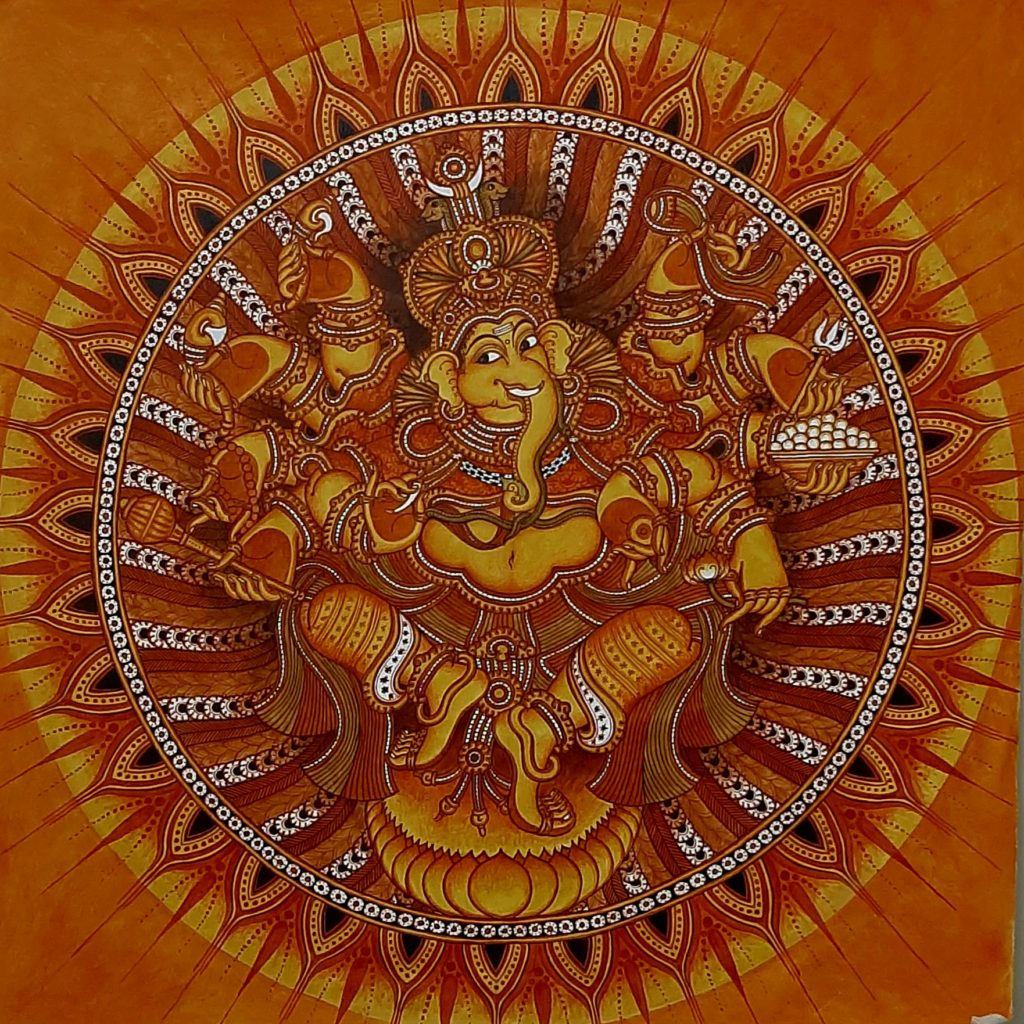
Buy Kerala’s Mural Paintings Online on Amazon India
Preserving the Legacy of Kerala Murals
Preserving Kerala’s mural heritage is a task of immense importance and complexity. Efforts in restoration and conservation have been undertaken by various organizations and the government. Specialized teams work meticulously to revive murals that have faded over time, using traditional techniques and materials to maintain authenticity.
However, the conservation process faces challenges, such as dealing with environmental factors like humidity and pollution, which accelerate deterioration. Additionally, finding skilled artisans who understand the traditional methods of mural creation is becoming increasingly difficult.
To address these challenges, initiatives to train new artists in ancient techniques are being implemented. Workshops and educational programs are being conducted to inspire and educate a new generation about the importance and intricacies of this art form. Furthermore, technological advancements, such as digital archiving, are being utilized to preserve the details of these murals for future generations. Through these concerted efforts, the legacy of Kerala murals continues to be safeguarded.

Experience Kerala’s Murals
To truly immerse in the world of Kerala murals, explore an interactive map highlighting the locations of famous mural sites across the state. From the ancient walls of the Mattancherry Palace to the sacred spaces of the Guruvayoor Temple, this map is your guide to the vivid world of Kerala’s artistic heritage.
For those inspired to learn the art, several institutions and workshops offer courses in Kerala mural painting. The Kerala Mural Painting Institute in Thrissur and the Raja Ravi Varma College of Fine Arts in Mavelikara are renowned for their comprehensive programs. Additionally, various workshops in Kochi and Thiruvananthapuram, conducted by practicing mural artists, provide hands-on experience in this traditional art form. These learning opportunities not only teach the techniques but also immerse students in the cultural significance of Kerala murals.
Kerala’s Mural Legacy: A Rich Tapestry of Myth and Modernity
Kerala boasts a rich collection of murals that rivals even the renowned state of Rajasthan in scale and significance. These murals, rooted deeply in ancient Indian mythologies, offer a vivid glimpse into a cultural past, with some dating back to the 8th century. This enduring legacy, however, is now witnessing a transformation. The traditional practice of wall murals is gradually giving way to artworks on canvas and paper, marking a shift that blends the time-honored with the contemporary. This evolution showcases the adaptability and enduring relevance of Kerala’s mural art in today’s artistic landscape.
Engagement and Call-to-Action:
I encourage all readers to embark on a journey to the stunning mural sites of Kerala. As you explore these artistic treasures, capture your experiences and the beauty you witness. Share your photographs and stories with us, creating a vibrant community space that celebrates and spreads awareness of this unique art form.
Additionally, for those passionate about cultural heritage, we’re excited to open a section for guest contributions. If you have insights, research, or experiences related to Kerala’s murals or other cultural topics, we welcome your submissions. Together, let’s keep the rich tapestry of Indian art and culture alive and thriving.

Ancient Origins and Grand Displays: Thirunandikkara and Krishnapuram Palace Murals
The journey into Kerala’s mural art takes us back to its ancient origins at the Thirunandikkara Cave temple, now part of Kanyakumari district in Tamil Nadu. These murals are revered as the oldest in Kerala, marking the beginning of this rich artistic tradition. In contrast to these ancient beginnings, the Krishnapuram Palace near Kayamkulam in Alappuzha district boasts the largest mural panel in Kerala, known as the Gajendra Moksha. This grand display of artistry not only showcases the scale of mural art but also the depth of storytelling that is characteristic of Kerala’s murals.

Ancient Beginnings and Masterpieces of Kerala Mural Art
The murals of Thirunadhikkara Cave Temple, now part of Tamil Nadu, and Tiruvanchikulam are revered as the oldest examples of Kerala’s unique style of mural paintings. These ancient artworks set the foundation for a rich tradition that flourished in the region. Among the masterpieces of Kerala mural art, the Shiva Temple in Ettumanoor, the Ramayana-themed murals in Mattancherry Palace, and the Vadakkumnatha Kshetram stand out for their exceptional artistry and intricate detail, symbolizing the pinnacle of this traditional art form.
Epic Narratives in Color: Mattancherry Palace and Ettumanoor Temple Murals
At Mattancherry Palace in Ernakulam district, extensive murals bring to life scenes from the Hindu epics, the Ramayana and the Bhagavatha. These vibrant paintings are not just displays of artistic skill but are visual narrations of age-old stories, deeply embedded in Indian culture. Meanwhile, the murals at the Shiva Temple in Ettumanoor offer a glimpse into the earliest forms of Dravidian mural art, marking the inception of this intricate art form. Together, these murals not only decorate sacred and historical spaces but also serve as custodians of India’s rich mythological heritage.
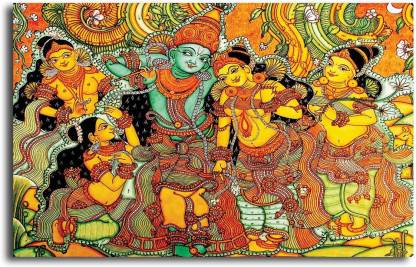
The Vibrant Murals of Kerala: Contrasting Simplicity and Opulence
In the realm of Kerala’s temples, simplicity reigns supreme, a stark contrast to the ornate and sculptured marvels of neighboring Tamil Nadu. Kerala’s temples, often modest in architectural design, find their splendor not in grandeur but through the vibrant murals that adorn their walls. These murals bring to life a world of color and myth, turning the simple structures into canvases of cultural storytelling. This unique approach to temple art highlights Kerala’s distinct aesthetic sensibility, where the vibrancy of mural art beautifully compensates for architectural simplicity.
Buy Kerala’s Mural Paintings Online on Amazon India
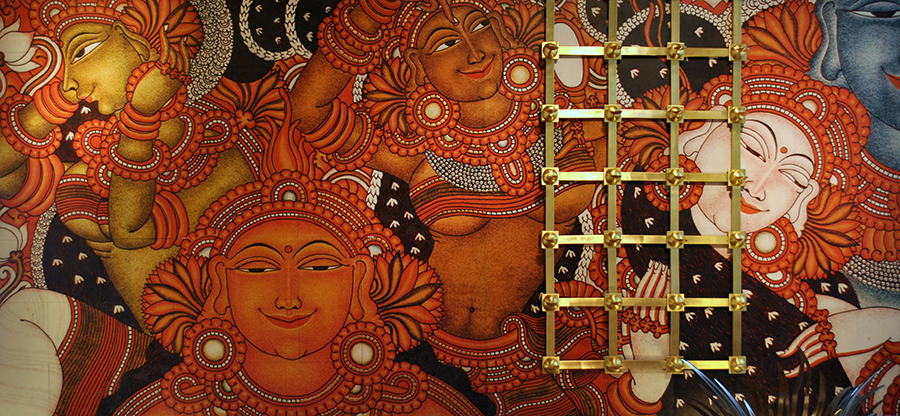
The Vibrant Tapestry of Kerala Murals: Myths and Stylization
Kerala murals are a vibrant tapestry that intricately weaves tales from the Puranas, the Ramayana, and the Mahabharata, presenting deities like Vishnu and Shiva in majestic forms. These paintings are distinguished by their highly stylized depiction of gods, characterized by wide-open eyes, elongated lips, and exaggerated eyebrows, reminiscent of classical Kerala theatre. The murals also feature an array of animals and vegetation, executed with technical brilliance. Limited to a palette of Panchavarna—red, yellow, green, black, and white—the colors are sourced from natural materials, adding to the murals’ ethereal and timeless beauty.


Kerala’s Temples: Beacons of Mural Artistry
Kerala’s temples stand as beacons of mural artistry, each narrating stories through vibrant wall paintings. From the divine depictions at Vadakkunatha in Thrissur to the intricate murals of Thiruvanchikkulam, these temples showcase a spectrum of styles and themes, reflecting their historical significance. The Pisarikkavau Temple’s murals represent spiritual narratives, while the Mulakkulam and Elamkkunnapuzha temples in Kottayam and Ernakulam display unique artistic techniques. Similarly, the Balusserry Temple in Kozhikode, along with the Thodikkalam and Lokanarkavu temples, are adorned with murals that highlight the cultural richness of the region. Each temple, through its mural paintings, contributes significantly to Kerala’s illustrious tapestry of religious and artistic heritage.


Beyond Temples: Murals in Kerala’s Palaces and Churches
While Kerala’s mural tradition began on the sacred walls of temples, it eventually found a splendid canvas in the palaces and churches of the region. In palaces, these murals majestically depict themes from Hindu epics, transforming royal walls into epic narratives. Churches, such as St Mary Sunoro in Angamaly, St George in Paliekkara, and others in Cheppad, Kanjoor, Paravur, Akaparambu, Angamaly, Ollur, Kadamattom, and Kottayam, adopted this art form to beautifully illustrate Biblical stories. This expansion signifies the versatility of mural art and its ability to bridge different cultural and religious narratives.
Preserving Kerala’s Iconic Murals: A Call for Restoration
Kerala murals, renowned as some of the most iconic artworks in India, now face the threat of time. Notably, the ancient murals at the Sri Rama Temple in Triprayar near Thrissur, and the Mahadev Temple in Thiruvanchikulam have shown significant deterioration. These precious pieces of heritage urgently require restoration to safeguard their beauty and historical significance. This call for preservation underscores the need to maintain these cultural treasures for future generations.
Conclusion:
Kerala murals are not just a form of art; they are a vibrant thread in the cultural tapestry of India, embodying centuries of tradition, spirituality, and artistic excellence. These murals tell stories of gods and legends, bringing to life the rich heritage of Kerala. As we explore these ancient artworks, we connect with a past that continues to resonate in the present.
I invite you, the readers, to share your own experiences or thoughts about Kerala murals. Have you visited any of these historic sites, or perhaps tried your hand at this unique art form? Your insights and stories can further enrich our appreciation of this splendid artistic legacy. Please share your thoughts in the comments section below.
Buy Kerala’s Mural Paintings Online on Amazon India
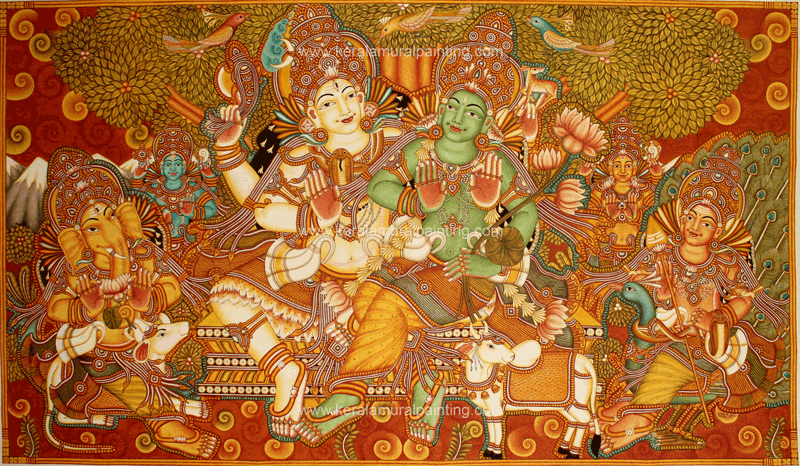

12 replies on “Unraveling the Enchanting World & Beauty of Kerala’s Unique Mural Paintings”
beautiful
Such a beautiful and elegant art form. Thank you for this article this is very informative and well explained. To learn this artform must visit https://www.penkraft.in/LiveKeralaMural
Hello,
Some of the painting images are used in your website with out our permission and have copy right issues. Please change the images of watermarked “www.keralamuralpainting.com” and Radha Krishna painting.
Thank you
Will do it, as you don’t want to see your pictures on my Blog. But would be grateful if you grant me permission to share your pictures, as the blog is meant solely for promoting the glorious cultural and spiritual heritage of India to every nook & corner of the globe, and is not a commercial venture.
Great information. I absolutely appreciate this . I am an art enthusiast and very fond of Kerala Mural Art and its products , so recently I have come across this website hope it will be help to many.
https://gifts.penkraft.in/Product-Details/PK-G-14/Decorative-Chopping-board-by-Penkraft–exclusively-hand-painted-in-Kerala-Mural-art/54
I want god shiva family photo frame which is presented first in this blog, how can I get this painting.
Please explore this link to spot your painting : https://keralamuralpainting.com/kerala-mural-paintings/
And then write to the Keral mural artist clicking this link : https://keralamuralpainting.com/contact/
I am sure you’ll find the above links useful
Wow nicely explained. To buy products related to this art from or a DIY kit o create your own art piece please visit
https://diy.penkraft.in/ArtFormDetails/EthnicArtForms/KeralaMuralArt
Hi…thank you for such a beautiful article…I love trying new art forms…I found this great website that provides DIY kits for different art forms and I am so happy after using it. I’ll drop the link here for reference
https://www.mystore.in/en/seller/58e0b914c565a67d7153577beee645c3
https://diy.penkraft.in/ArtFormDetails/EthnicArtForms/DotMandala
This blog is so amazing. Thanks for this information. Here’s a link to where I bought this https://diy.penkraft.in/ProductDetails/Kerala-Mural-art-on-Canvas-DIY-Kit-by-Penkraft
https://www.mystore.in/en/product/1525493f647ffd9dcbaaf734f4d06c3e
I am thoroughly impressed by the depth of knowledge and analysis presented in this Art blog.. I will drop the link here for reference
https://youtu.be/YOwf1CKYk9o
https://youtu.be/_WnsNm9Z1JM
https://youtu.be/VXelDHNXnV4
https://youtu.be/80s1wuauElA
This is so beautiful art and i have always loved buying this and i found a great website for this
https://diy.penkraft.in/ProductDetails/Kerala-Mural-art-on-Canvas-DIY-Kit-by-Penkraft